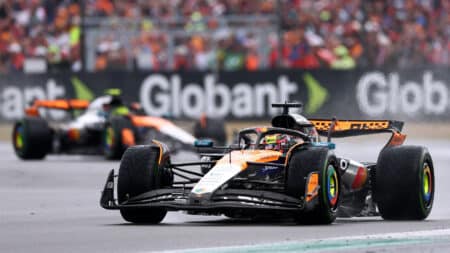
Horner's departure shows age of the maverick F1 boss is over
Christian Horner has now left Red Bull, the last of a certain breed of F1 team principal
In essence it’s a prime slice of rural Oxfordshire, a brisk, open B-road lined by low hedges that permit good sight lines – except on mornings such as this, when the area is cloaked in fog. For the most part this is the realm of pheasants, but peel through an unmarked gate and – barely visible from the main drag – you’ll find a small industrial hub with strong motor sport connections.
Aston Martin Racing is based here, likewise the UK headquarters of racewear manufacturer Sparco, rally specialist David Appleby Engineering and, as of recently, the European arm of Chip Ganassi Racing, which has taken over the former premises of touring car team Triple Eight Engineering to supervise Ford’s assault on the World Endurance Championship and, perhaps particularly, the Le Mans 24 Hours.
It is 50 years since Ford scored its maiden Le Mans win – only three of 13 competing GT40s made the finish that year, which might seem a poor strike rate had not the trio of survivors completed a podium clean sweep – but this time the objective will be class success rather than outright victory. And you can tell from the drivers’ demeanour that they consider this a realistic possibility.
Britons Andy Priaulx and Marino Franchitti will share WEC cockpit duties with Frenchman Olivier Pla and German Stefan Mücke, with two extras (as yet unannounced) drafted in for Le Mans. There is no shortage of experience here: Pla and Mücke have previously taken class podiums at Le Mans, as has triple touring car world champion Priaulx, while Franchitti was part of the winning team in the 2014 Sebring 12 Hours… in a Ganassi-run Riley with Ford running gear similar to that in the new GT. It might be based on a road car that has yet to be launched, but the bits below the surface have strong competition credentials. Plus, of course, Ganassi’s US-based IMSA GT team will cross the Atlantic in June to complete Ford’s four-pronged Sarthe assault. “The goal is very definitely to win both Le Mans and the championship,” Mücke says.
A striking appearance is no guarantee of competitive zest, but the new GT certainly has presence. “It actually goes even better than it looks,” Franchitti says. “When I first tested the car at Daytona last year, it felt right absolutely straight away. In fact [team principal] George Howard-Chappell had to more or less prise me from my seat. I didn’t want to get out.”
From the Archive: Denis Jenkinson drives the original Ford GT (December 1966)
The team’s factory is compact and functional in the manner of old, the accent on performance rather than pointless décor that’s worth nothing in terms of lap time. For the launch, though, two Mustangs have been parked outside, each finished in a shade of yellow that’s loud enough to pierce the mist. “One of those is my new road car,” says Franchitti, scrolling frantically through his mobile phone’s image bank until he finds what he’s after. “Look,” he says. “That’s the original logbook for my late grandfather’s Capri 3.0 GT, which we called ‘the canary’ because it was a similarly bright yellow. I guess the canary is flying again.”
He’s not the only one for whom the marque’s allure extends beyond a strong competition pedigree. “It’s an honour to be part of a programme such as this, with so much tradition,” Ganassi says, “but I also recall playing with a GT40 slot car as a child. The Ford GT and I go back a long way.”

Christian Horner has now left Red Bull, the last of a certain breed of F1 team principal

Was Oscar Piastri the real winner in the long run after Silverstone? asks James Elson

Lewis Hamilton hadn't won in almost three years – and then produced a sensational victory at Silverstone 2024. James Elson explains why it was his best ever

Describing this year's championship race as a 'battle' might be slightly over-egging it, writes James Elson